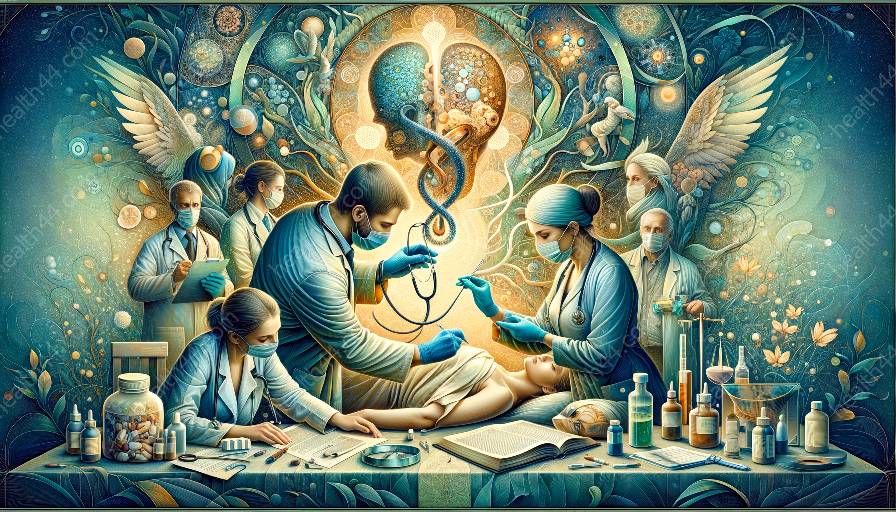The study of renal anatomy and physiology is an essential aspect of comprehending nephrology and internal medicine. The kidneys play a vital role in maintaining overall health, and understanding their intricate structure and complex physiological processes is crucial for healthcare professionals. In this comprehensive guide, we will delve into the details of renal anatomy and physiology, exploring the structure and function of the kidneys and their significance in clinical practice.
The Renal System: An Overview
The renal system, also known as the urinary system, consists of the kidneys, ureters, urinary bladder, and urethra. The kidneys are bean-shaped organs located on either side of the spine, below the ribcage. They play a crucial role in maintaining homeostasis by regulating the body's fluid balance, electrolyte levels, and waste elimination.
The Anatomy of the Kidneys
The kidneys are complex organs with a highly organized structure that enables them to perform their essential functions. Each kidney consists of an outer layer called the renal cortex, an inner region known as the renal medulla, and a central space called the renal pelvis. Within the renal medulla, there are structures called renal pyramids, which are responsible for the production of urine.
Nephrons: The Functional Units of the Kidney
At the microscopic level, the nephron is the basic functional unit of the kidney. Each kidney contains millions of nephrons, each of which consists of a renal corpuscle and a renal tubule. The renal corpuscle comprises the glomerulus, a network of capillaries, and the Bowman's capsule, which surrounds the glomerulus. The renal tubule consists of several segments with specific functions, including reabsorption, secretion, and urine concentration.
Kidney Function: Filtration, Reabsorption, and Secretion
The kidneys perform the crucial task of filtering the blood to remove waste products and excess substances, while simultaneously reabsorbing essential molecules to maintain the body's balance. Filtration occurs as blood flows through the network of capillaries in the glomerulus, where small molecules are forced out of the blood and into the renal tubule. Reabsorption takes place as various substances are transported from the renal tubule back into the blood to maintain the body's homeostasis.
Secretion involves the movement of substances from the blood into the renal tubule to be eventually excreted in the urine. These intricate processes enable the kidneys to regulate the body's fluid and electrolyte balance, control blood pressure, and eliminate waste products efficiently.
Renal Blood Supply and Nerve Innervation
The kidneys receive a significant volume of blood flow to support their essential functions. Renal arteries branch off from the aorta to supply oxygenated blood to the kidneys, and renal veins transport filtered blood back to the systemic circulation. Additionally, the kidneys are innervated by sympathetic nerves, which play a role in regulating renal blood flow and fluid balance.
Clinical Significance of Renal Anatomy and Physiology
Understanding the intricacies of renal anatomy and physiology is crucial for diagnosing and managing a wide range of renal conditions. Healthcare professionals, particularly those specializing in nephrology and internal medicine, rely on this knowledge to assess kidney function, interpret laboratory tests, and design treatment plans for patients with renal diseases.
Common Renal Disorders and Diseases
Disorders of the kidneys can lead to significant health complications, ranging from electrolyte imbalances to chronic kidney disease and end-stage renal failure. By understanding renal anatomy and physiology, clinicians can diagnose conditions such as acute kidney injury, glomerulonephritis, diabetic nephropathy, and polycystic kidney disease. This knowledge is essential for providing timely and effective interventions to preserve kidney function and improve patient outcomes.
Diagnostic Tools and Imaging Techniques
Advanced diagnostic tools and imaging techniques play a crucial role in assessing renal anatomy and physiology. Healthcare professionals use laboratory tests, such as serum creatinine and estimated glomerular filtration rate (eGFR), to evaluate kidney function. Imaging modalities, including ultrasound, computed tomography (CT), and magnetic resonance imaging (MRI), provide detailed visualization of the kidneys, ureters, and bladder, aiding in the diagnosis of renal conditions.
Therapeutic Interventions and Management Strategies
Based on an in-depth understanding of renal anatomy and physiology, nephrologists and internists develop individualized treatment plans for patients with renal diseases. Therapeutic interventions may include medications to control blood pressure, manage electrolyte imbalances, and preserve kidney function. In cases of advanced kidney disease, healthcare professionals may consider renal replacement therapies such as dialysis or kidney transplantation.
Conclusion
The comprehensive understanding of renal anatomy and physiology forms the cornerstone of nephrology and internal medicine. By gaining insights into the intricate structure and complex functions of the kidneys, healthcare professionals can effectively diagnose, manage, and treat a wide range of renal disorders. This knowledge not only contributes to improving patient outcomes but also underscores the indispensable role of renal health in maintaining overall well-being.


